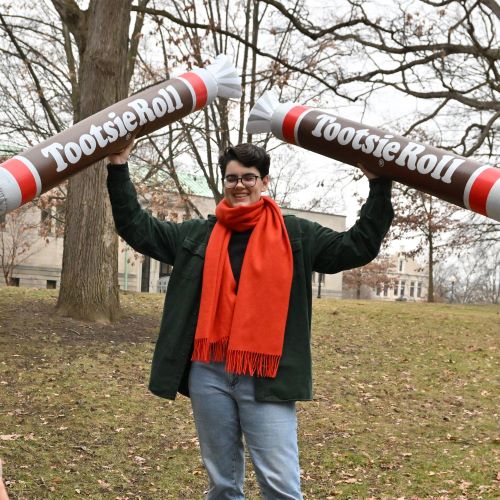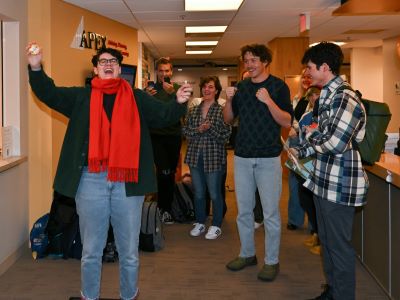
Environmental studies major finds vibrant communities in Denmark cohousing research

In the age of technology, connecting to those closest to you seems like it would be easy, but some people don’t even know the names of their own neighbors. Alice Markey ’23 enjoys the vibrant sense of community she experiences living less than a five-minute walk away from friends at The College of Wooster. Junior year, she became interested in urban design and how physical environments can influence social behavior. She also wondered how her connections with friends would change after college. “I was convinced that adulthood would be challenging to hang out with friends because everyone’s schedule is different, and you don’t live in the same city anymore,” she said. But she found hope for what the future could look like after studying abroad in Denmark and completing an Independent Study on cohousing (or Bofællesskab in Danish).
“Nothing about cohousing is accidental. Everything is designed to create a robust and strong community.” —Alice Markey ’23, Environmental studies major, I.S. title: Together, We Can Everything: The Social Outcomes of Cohousing Communities in Denmark
Instead of large yards, individual homes in a cohousing community are closer together with sidewalks connecting each front door. All homes face a central location, like a courtyard or garden. “Nothing about cohousing is accidental,” said Markey. “Everything is designed to create a robust and strong community.” In addition to 14-35 individual homes, each community has a common house or hang-out space with an industrial kitchen and a large dining room where everyone eats together.
“The model of living together in what is essentially a village is not a new idea at all,” said Markey. “Africans and Native Americans have been living in villages together all over the world forever, and many northern European countries have forms of cohousing today.” She explained the idea’s origination in Denmark was in the 1970s when an article titled, “Every Child Should Have 100 Parents” inspired a shift toward designing neighborhoods into centralized communities. Instead of playing in the street unsupervised, a child could run around the entire neighborhood and knew they could ask any resident for help if they needed to. Parents had more help and children had more freedom within the community.
Ironically, Markey spent 18 months searching for this article (which was mentioned in several of the pieces she read prepping for her research) and was shocked to find a paper copy at the home of one of her interviewees. “It was wild to go through the whole process and find this article at the end,” recalled Markey.
Markey planned to focus on the environmental sustainability aspect of cohousing, but after first-person interviews of 20 residents across eight communities near Copenhagen, she was surprised when the topic didn’t really come up. “I went in kind of assuming that people make their own decisions about single-use water bottles, plastic bags, etc., but I found that the European Union requires people to use the most sustainable light bulbs, and everyone has to sort their trash into 12 different categories for specific recycling uses,” explained Markey. “Sustainability is the default there. While cohousing communities can be more sustainable because they cook in bulk with less food waste and streamline energy consumption in the common house, sustainability isn’t a motivator for joining a community.”
After spending the spring 2022 semester studying in Denmark, she returned in July to conduct interviews and began analyzing the hours of transcripts when she returned to campus in the fall. Markey discovered three key themes at play. The first is the investment. Residents invest time, money, and emotional labor to be successful. It often costs more than single-family homes and residents are required to participate in common workdays for gardening, etc. Still, waitlists to live in a cohousing community can be years long, and most people who move in never leave (until they pass away). The next piece is values. Everyone works together to cook dinner, meet monthly, and take care of the physical space. The last and most important piece is the social aspect. Positive social outcomes only occur when everyone in the community aligns on investment and values.
“People feel like a giant family where there’s a lot of social support and connections with emotional and physical proximity,” said Markey who described the month-long interview process as eye-opening. “There are 80- and 90-year-olds who raised kids here and they now live in their own cohousing space, and I talked to a woman in her 70s whose daughter lives in the same community. That was cool.”
Though  the idea of cohousing isn’t as common in the United States, Markey said her research gave her hope about the future. “Cohousing provides a model that goes against traditional societal norms about how adulthood should be and how families should be,” said Markey. “The default does not have to be your own house where you don’t go outside, and you don’t know who your neighbors are. There are places in the world where you really feel like part of a family in these communities.”
the idea of cohousing isn’t as common in the United States, Markey said her research gave her hope about the future. “Cohousing provides a model that goes against traditional societal norms about how adulthood should be and how families should be,” said Markey. “The default does not have to be your own house where you don’t go outside, and you don’t know who your neighbors are. There are places in the world where you really feel like part of a family in these communities.”
Like the communities she studied, Markey built a strong relationship with her faculty mentor, Matt Mariola, associate professor and program chair of environmental studies, and ultimately completed her study two months before the deadline—earning the #2 I.S. button. She also identified several possible next steps to the research, including longitudinal studies inter viewing the same people she talked to 10 years from now to see how things have changed. She also suggests talking to the kids raised in cohousing after they become adults to better understand their experiences.
As for her own future, Markey found a new interest through her research that she plans to explore. “I definitely discovered my passion for interviewing,” she said. “I’m still undecided on what I’m doing after graduation, but I want to apply the interviewing, writing, and qualitative research skills I gained with I.S. in whatever job I have.”
Posted in Independent Study on May 11, 2023.
Related Posts
Related Areas of Study
Environmental Studies
Natural sciences, social sciences, and humanities courses combine for those who want to be part of environmental solutions
Major Minor

